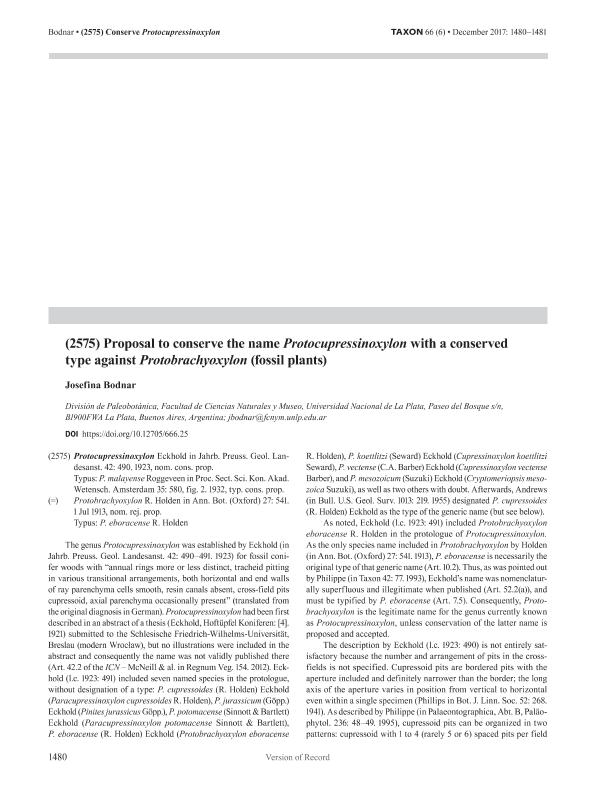Mostrar el registro sencillo del ítem
dc.contributor.author
Bodnar, Josefina

dc.date.available
2019-04-17T18:48:44Z
dc.date.issued
2017-12
dc.identifier.citation
Bodnar, Josefina; (2575) proposal to conserve the name Protocupressinoxylon with a conserved type against Protobrachyoxylon (fossil plants); International Association for Plant Taxonomy; Taxon; 66; 6; 12-2017; 1480-1481
dc.identifier.issn
0040-0262
dc.identifier.uri
http://hdl.handle.net/11336/74598
dc.description.abstract
The genus Protocupressinoxylon was established by Eckhold for fossil coniferwoods with annual rings more or less distinct, tracheid pitting in various transitional arrangements, both horizontal and end walls of ray parenchyma cells smooth, resin canals absent, cross-field pits cupressoid, axial parenchyma occasionally present. Eckhold included Protobrachyoxylon eboracense R. Holden in the protologue of Protocupressinoxylon. As the only species name included in Protobrachyoxylon by Holden P. eboracense is necessarily the original type of that generic name. Thus, as was pointed out by Philippe, Eckhold's name was nomenclaturally superfluous and illegitimate when published, and must be typified by P. eboracense. Consequently, Protobrachyoxylon is the legitimate name for the genus currently known as Protocupressinoxylon, unless conservation of the latter name is proposed and accepted. Despite some inconveniences, conservation of the name Protocupressinoxylon is proposed here considering that the legitimate name, Protobrachyoxylon, has fallen into oblivion. By contrast, Protocupressinoxylon has been widely used in palaeobotany for fossil woods ranging from Permian to Cretaceous from all over the world (21 countries from the five continents). More than 40 references to the genus were found in the literature, including contributions on anatomy and taxonomy, paleoecology and paleoclimatology, and biogeography. In xylological literature Protocupressinoxylon is used by most authors as the name of a fossil genus including woods with transitional tracheid pitting and both araucarioid and/or the cupressoid cross-fields, which causes difficulties with the circumscription of the genus. However, a detailed analysis of the available information demonstrates that the prevailing usage of the generic name Protocupressinoxylon is for wood with cupressoid cross-fields. It is proposed that conservation of Protocupressinoxylon be with a conserved type in view of the fact that the original specimens of the species names included in the protologue are lost or do not match the diagnosis. The conserved type proposed is Protocupressinoxylon malayense Roggeveen.
dc.format
application/pdf
dc.language.iso
eng
dc.publisher
International Association for Plant Taxonomy

dc.rights
info:eu-repo/semantics/openAccess
dc.rights.uri
https://creativecommons.org/licenses/by-nc-sa/2.5/ar/
dc.subject
Fossil Wood
dc.subject
Conifer
dc.subject
Nomenclature
dc.subject.classification
Paleontología

dc.subject.classification
Ciencias de la Tierra y relacionadas con el Medio Ambiente

dc.subject.classification
CIENCIAS NATURALES Y EXACTAS

dc.title
(2575) proposal to conserve the name Protocupressinoxylon with a conserved type against Protobrachyoxylon (fossil plants)
dc.type
info:eu-repo/semantics/article
dc.type
info:ar-repo/semantics/artículo
dc.type
info:eu-repo/semantics/publishedVersion
dc.date.updated
2019-03-15T18:24:31Z
dc.identifier.eissn
1996-8175
dc.journal.volume
66
dc.journal.number
6
dc.journal.pagination
1480-1481
dc.journal.pais
Austria

dc.journal.ciudad
Viena
dc.description.fil
Fil: Bodnar, Josefina. Consejo Nacional de Investigaciones Científicas y Técnicas; Argentina. Universidad Nacional de La Plata. Facultad de Ciencias Naturales y Museo. Área Paleobotánica; Argentina
dc.journal.title
Taxon

dc.relation.alternativeid
info:eu-repo/semantics/altIdentifier/url/https://onlinelibrary.wiley.com/doi/10.12705/666.25
dc.relation.alternativeid
info:eu-repo/semantics/altIdentifier/doi/https://doi.org/10.12705/666.25
Archivos asociados
